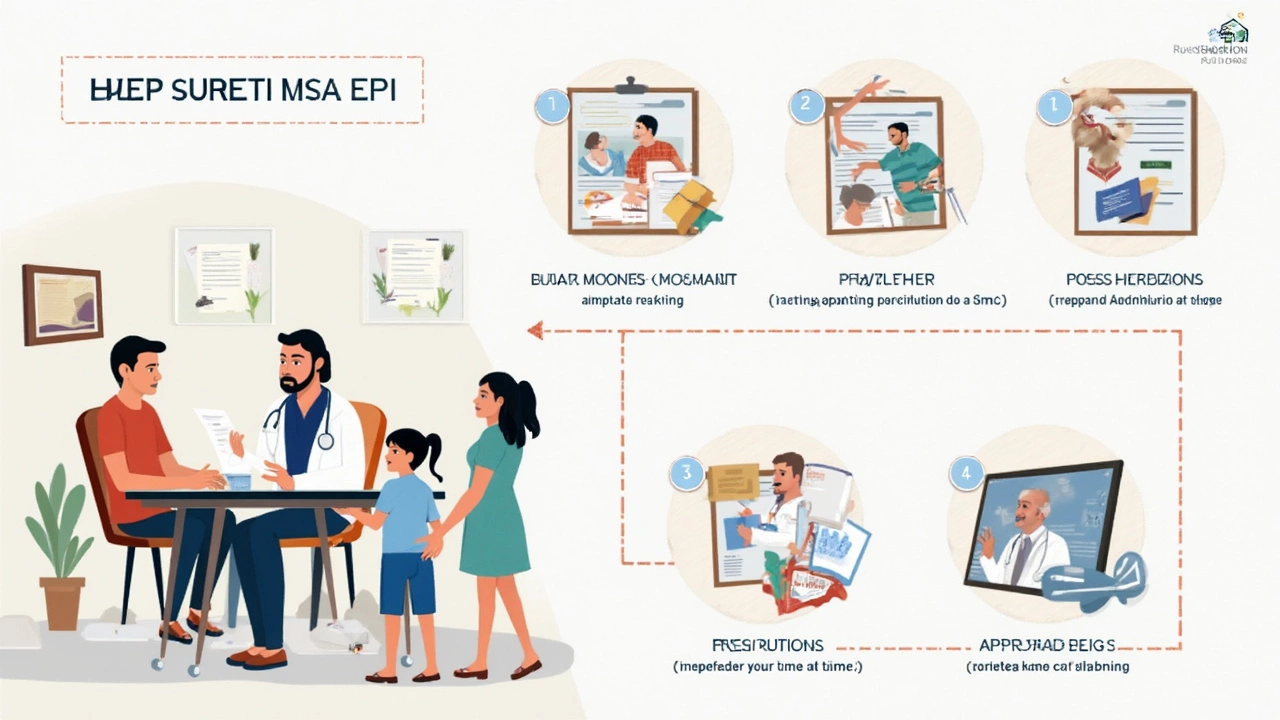So you're stuck with a bed that's making your back worse or maybe your doctor says it's time for a hospital bed at home. Here's where Medicare can actually help—if you follow a few steps and know what boxes you need to check.
The first thing most people want to know is whether Medicare covers a whole new bed, or if it's only about hospital beds. The answer is yes, but not just any bed: Medicare calls these “durable medical equipment,” which means things you actually need for health, not just comfort. If you want a specific mattress or cushion (especially for pressure sores or chronic pain), there are some rules—and a bit of paperwork.
Here’s the honest truth: the process gets a little bumpy if you don’t have all the right documents lined up. You don't want to buy a bed and then find out Medicare won’t reimburse you, so timing (and getting the right prescription) really matters. Stick with me—I’ll explain what Medicare needs and what you should avoid to make things go a lot smoother.
- What Kinds of Beds Does Medicare Cover?
- Qualifying for a Medicare-Paid Bed
- How to Apply (And What to Watch Out For)
- Extra Help: Cushion Coverage and Tips
What Kinds of Beds Does Medicare Cover?
Medicare isn’t handing out any bed you want—it’s all about beds and mattresses with a medical purpose. The big term here is “hospital bed,” but in reality, it covers a range of beds that help with specific health problems. If you’re looking for fancy upgrades or just a softer mattress, Medicare probably won’t pay, but if you’ve got a real medical need, there’s a good chance you’re covered under Medicare Part B.
Here’s what Medicare usually helps with:
- Manual Hospital Beds: These need you (or someone helping you) to crank them by hand to move the head or foot up and down. Basic but functional.
- Semi-Electric Hospital Beds: These have a motor for the head and foot, but the height still gets adjusted by hand. Most folks end up with this one if they qualify.
- Full-Electric Hospital Beds: Medicare only covers these in rare cases, usually if you absolutely can’t operate a manual bed safely.
- Pressure-Relief Mattresses and Overlays: If you’re at risk of bed sores or already have pressure ulcers, Medicare covers certain special mattresses and alternating pressure pads.
If you’re curious about other sleep surfaces, like memory foam or air beds, those aren’t covered unless they serve a medical need—think severe wounds or a doctor’s prescription for pressure management.
Here’s a quick look at what’s usually covered—and what’s not:
| Type | Covered? | Who Usually Qualifies |
|---|---|---|
| Manual Hospital Bed | Yes | Anyone who needs head/foot raised for health |
| Semi-Electric Bed | Yes | Most with mobility/respiratory issues |
| Full-Electric Bed | Usually No | Only if can’t use manual/semi-electric |
| Standard Mattress | No | Medical need only (rare) |
| Alternating Pressure Mattress | Yes | High risk of pressure sores |
Medicare almost always requires you to rent the bed instead of buying it outright, unless it’s cheaper to buy. One myth: Medicare won’t pay for cushy pillows or purely comfort-based cushions. It only covers pressure-relieving pads and similar gear that’s medically necessary.
Qualifying for a Medicare-Paid Bed
It’s not enough to just need a better bed—Medicare has clear requirements you gotta meet before they’ll shell out any cash for a new one. You can't just say,

How to Apply (And What to Watch Out For)
Getting Medicare to pay for a new bed is more like a checklist than a wild goose chase—if you know the steps. You have to jump through a few hoops, but it pays off when you’re not footing the whole bill yourself.
Here’s a play-by-play on what you need to do:
- Get a Face-to-Face Visit with Your Doctor: Your doctor has to see you in person and say, in their medical notes, exactly why you need a special bed. The note should spell out your medical condition and explain why a regular bed won’t cut it. This visit should happen no more than 6 months before getting your bed.
- Ask for a Written Prescription: The prescription should say what kind of bed is needed. It gets attached to your file when you order the bed.
- Choose a Medicare-Approved Supplier: Not every store or online seller gets the green light from Medicare. Find a supplier who’s officially enrolled and participating, not just "enrolled" (makes a difference in coverage!).
- Submit the Right Paperwork: The supplier usually helps send your paperwork to Medicare, but double-check that your doctor’s notes and prescription are all there. Missing info stalls everything.
Now, here’s where it gets sticky:
- Buying the bed first and asking for reimbursement almost never works. Medicare wants to approve your request before you get the bed—so always wait for a green light.
- If the supplier is "non-participating," you could end up paying more out of pocket. Make sure they take assignment so you pay the least.
- Medicare covers 80% of approved costs. You cover the other 20% unless you have extra insurance that picks up the difference.
The approval odds really depend on your paperwork and how well your doctor documents your need. In recent surveys, about 65% of denied claims were because of incomplete paperwork or missing medical need details. So, don’t just trust the supplier—double-check everything. Ask for copies for your file.
| Key Step | Common Problems | Pro Tip |
|---|---|---|
| Doctor visit & notes | Notes too vague | Ask doctor to mention mobility, pain, and daily impact |
| Supplier choice | Supplier not “participating” | Check the Medicare supplier list online |
| Paperwork | Missing prescription or dates | Keep copies of everything you submit |
It’s not fast—approval can take a week or even a month, depending on how quick everyone is. If the first request gets denied, you can appeal—don’t panic, just ask what’s missing and resubmit with more details from your doctor.
Extra Help: Cushion Coverage and Tips
A lot of folks forget that Medicare can pay for not just the bed, but certain cushions that make a real difference if you’re dealing with pressure sores, are stuck in bed for long stretches, or have mobility limits. These aren’t standard pillows or foam toppers from the store—they’re medical cushions, and you need the right paperwork to get them covered.
The most common ones Medicare pays for fall under “pressure-reducing support surfaces.” Think specialized foam, gel, air, or alternating pressure mattresses and overlays. The big thing is that regular beds or over-the-counter stuff don’t count; it’s got to be labeled as durable medical equipment (DME) and come from a Medicare-approved supplier.
- Your doctor has to document either impaired mobility or a medical diagnosis, like a stage 2 or higher pressure ulcer, as the key reason you need a special cushion.
- Only a small number of medical suppliers are approved for this gear—always make sure they’re in Medicare’s DME database before you order anything.
- If you’re looking at an alternating pressure pad or low air loss mattress, your medical records need to show you’ve tried standard therapies first (like turning schedules or regular repositioning) and those didn’t work.
Medicare usually covers 80% of the allowed amount for DME after you meet your Part B deductible. The price difference between cushions sold as DME and those on regular store shelves can be shocking. Check out the real numbers below:
| Type of Cushion/Surface | Medicare-Allowed Price Range | Regular Retail Price |
|---|---|---|
| Gel Overlay | $120 – $200 | $40 – $90 |
| Alternating Pressure Mattress | $600 – $1,000 | $180 – $400 |
| Low Air Loss Mattress | $800 – $2,500 | $300 – $900 |
Here’s what actually works when you want Medicare to pay its share for a new bed or special cushion:
- Get a prescription and detailed doctor’s note that spells out your diagnosis and why you need a medical cushion—not just for comfort, but for real medical reasons.
- Make sure you only order through a Medicare-enrolled DME supplier. Ask upfront if they’ll submit claims for you. Some stores say they “accept Medicare” but expect you to pay full price and deal with paperwork yourself—don’t get stuck with that.
- Tell your doctor exactly what’s going on. Mention any redness, sores, pain, or changes in mobility so they put it in your chart. The details matter for Medicare approval.
If you’re having trouble with paperwork or denials, reach out to your local State Health Insurance Assistance Program (SHIP) for free one-on-one help. They know all the quirks and shortcuts for getting Medicare to cover these supplies.
